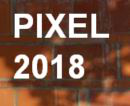Speaker
Description
MÖNCH is a hybrid silicon pixel detector based on charge integration and with analog readout, featuring a pixel size of 25x25 μm2. The latest working prototype (MÖNCH 03) consists of an array of 400×400 identical pixels for a total active area of 1×1 cm2. Its design is optimized for the single photon regime. The chip has an ENC in the order of 35 electrons RMS and a dynamic range of ~4×12 keV photons in high gain mode, which increases to ~100×12 keV photons with the lowest gain setting.
The ATHOS beamline, in construction at present at the Swiss Free Electron Laser (SwissFEL), has a minimum operating energy of 250eV with an extremely high photon flux. The low noise levels of MÖNCH make it a suitable candidate for X-ray detection at energies below 1 keV, However, the architecture implemented in MÖNCH03 does not provide enough dynamic range for applications at the SwissFEL. For this reason a new large area prototype (MÖNCH 04) is being designed, targeting energy sensitivity down to at least 500eV, single photon resolution down to 800eV and a dynamic range of at least 10000 x 800eV photons. At the same time, a collaboration with FBK (Trento, Italy) has been established to develop thin entrance window sensors, needed to reach enough detection efficiency at low photon energies.
The latest characterization results of the previous MÖNCH prototypes will be presented, with special emphasis on the low-energy results, including the behavior of the fist detector samples of different flavors produced by FBK. The design of MÖNCH 04 and the proposed solutions to the challenges that it has to address will be shown. Finally, the prospects for the design, optimization and commissioning of the larger area module (4x6 cm2) required by ATHOS will be discussed.
